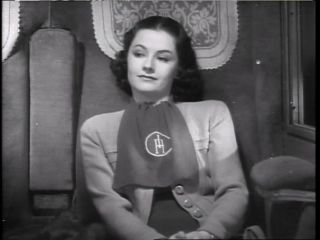The MacGuffin: News and Comment (09/Feb/2008)
(c) Ken Mogg (2008)
February 9
In both the 1936 novel called 'The Wheel Spins' and Hitchcock's 1938 film of it, called The Lady Vanishes, the governess Miss Froy tends to chatter sweetly about her fancies. (Early in the film she bores Charters and Caldicott into near-drowsiness!) Talking to Iris on the train, the novel's Miss Froy reveals that she's a spinster, the daughter of a clergyman, but claims to 'still have the excitement and hope of the eternal quest. I never forget that a little boy is born for every little girl. And even if we haven't yet met, we are both growing old together, and if we're fated to meet, we shall.' This life-optimism is partly what the novel and the film are both about. But there's also a down-to-earth aspect. For example, here's how the novel continues: 'Iris thought sceptically of the mature men who refuse to adhere to the calendar, as she listened [to Miss Froy's chatter] with rising resentment. She wanted quiet - but Miss Froy's voice went on and on, like the unreeling of an endless talking-picture.' Or like an interminable train journey! Both the novel and the film draw comparisons between films and trains - and life. The novel's very title attempts to link its train setting with a wheel of fortune, and also the novel contains further allusions to the nature of film. At one point, Iris has 'the impression that the whole scene was flickering like an early motion-picture. The waiters swung down the rocking carriage balancing trays. Scraps of country flew past the window.' And, a few moments later, as she sits opposite Miss Froy, 'Iris [growing dizzy] watched the smoke curling up from her cigarette. Occasionally she saw a vague little puckered face swaying amid the haze, like an unsuccessful attempt at television.' (It's hardly a stretch to imagine that the spinning 'wheel' of the title could also be a film spool unwinding ...) Certainly Hitchcock was aware of these various parallels and gently took advantage of them, both in this film and later ones. (For example, whenever Hitchcock's characters go on a journey, typically at the start of a film, it's as if the audience were embarking with them.) Of course, various film theorists have lately emphasised trains as a metaphor for cinema. Slavoj Žižek begins his documentary, 'A Pervert's Guide to the Cinema' (2006), with a clip from Clarence Brown's Possessed (1931) showing a young Joan Crawford waving goodbye in the street to her yokel boyfriend Wallace Ford, then walking away. Next moment, at a level-crossing, she watches a luxury train with its screen-like windows slowly passing by, and her mind starts to race. (Soon she'll be heading for the big city and the arms of Clark Gable.) I shan't spell out the various physical correspondences between (watching) a film and (going on) a train journey, and how a certain dreaming and/or 'lowered consciousness' (Siegfried Kracauer's term) is induced by both experiences. And how a director like Hitchcock then paradoxically challenges his audience into 'mindfulness', so that not only the very narrative of TLV is about vigilance but at least one scene is built on Iris and Gilbert's need to stay awake. (If Hitch had filmed Frederic Brown's s-f novel 'The Mind Thing', as he nearly did before turning instead to Daphne du Maurier's short story 'The Birds', that novel's climax is posited on the hero's need to defeat the alien by staying awake - and no doubt Hitch would have included the episode in his film.) But I would like to insist, once again, on how Hitchcock was a Symbolist director, just as much as he was an expressionist one. ('For a while I even had Symbolist dreams', he once said.) The train journey in TLV is an unstressed metaphor for 'life' in at least two senses. Miss Froy's life-optimism, as I've called it, corresponds to what the philosopher Schopenhauer famously called 'the life-dream of the man who wills', i.e., of every one of us. Interestingly, when the film's Miss Froy makes her escape from the train near the end, she farewells her new friends by saying, 'I do hope and pray ... that we shall all meet again one day.' That sounds more than this-worldly and actually quite close to something Hitchcock would tell interviewer Charles Higham in the 1960s. Mentioning his project to film J.M. Barrie's play 'Mary Rose', the director revealed his belief that at some time in the future scientists would have found how to atomically disembody people and then later reassemble them so that we could be transferred 'to another place and come together there again'. (Higham and Greenberg, 'The Celluloid Muse', p. 103) Amazing! But TLV is also a metaphor for the down-to-earth aspects of 'life' I mentioned above. (My thanks at this point to Joel Gunz who reminded me during the week of a salutary observation by Joseph Campbell: 'life is like a movie to which we arrive late and leave early'.) For the first half of the film, Iris wears a monogrammed scarf with her initials, I.H., embroidered on it (see frame-capture below). It's a symbol of a certain narcissism and self-centredness. But after the baggage-car scene which - I suggest - functions in the narrative like a wake-up call to both Iris and Gilbert, and the moment when they cease being antagonists and start to feel the need to work together to save Miss Froy, Iris's scarf is seen no more: from that moment until her arrival back in London, she wears a sensible, modest cardigan. The theme here (roughly, of 'growing up') is one that will recur in such films as Lifeboat, Shadow of a Doubt, North by Northwest and The Birds.
This material is copyright of Ken Mogg and the Hitchcock Scholars/'MacGuffin' website (home page) and is archived with the permission of the copyright holder. |

